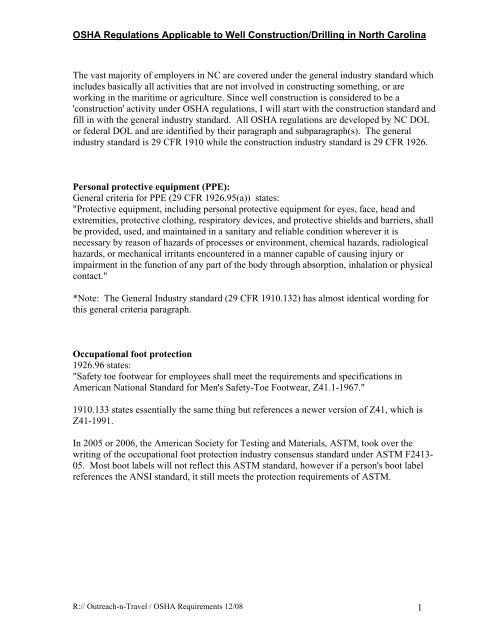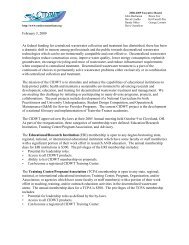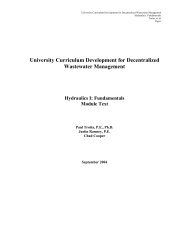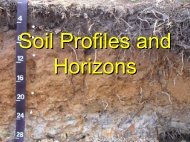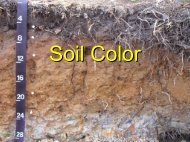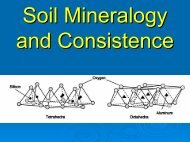OSHA Safety Requirements Reference
OSHA Safety Requirements Reference
OSHA Safety Requirements Reference
Create successful ePaper yourself
Turn your PDF publications into a flip-book with our unique Google optimized e-Paper software.
<strong>OSHA</strong> Regulations Applicable to Well Construction/Drilling in North Carolina<br />
The vast majority of employers in NC are covered under the general industry standard which<br />
includes basically all activities that are not involved in constructing something, or are<br />
working in the maritime or agriculture. Since well construction is considered to be a<br />
'construction' activity under <strong>OSHA</strong> regulations, I will start with the construction standard and<br />
fill in with the general industry standard. All <strong>OSHA</strong> regulations are developed by NC DOL<br />
or federal DOL and are identified by their paragraph and subparagraph(s). The general<br />
industry standard is 29 CFR 1910 while the construction industry standard is 29 CFR 1926.<br />
Personal protective equipment (PPE):<br />
General criteria for PPE (29 CFR 1926.95(a)) states:<br />
"Protective equipment, including personal protective equipment for eyes, face, head and<br />
extremities, protective clothing, respiratory devices, and protective shields and barriers, shall<br />
be provided, used, and maintained in a sanitary and reliable condition wherever it is<br />
necessary by reason of hazards of processes or environment, chemical hazards, radiological<br />
hazards, or mechanical irritants encountered in a manner capable of causing injury or<br />
impairment in the function of any part of the body through absorption, inhalation or physical<br />
contact."<br />
*Note: The General Industry standard (29 CFR 1910.132) has almost identical wording for<br />
this general criteria paragraph.<br />
Occupational foot protection<br />
1926.96 states:<br />
"<strong>Safety</strong> toe footwear for employees shall meet the requirements and specifications in<br />
American National Standard for Men's <strong>Safety</strong>-Toe Footwear, Z41.1-1967."<br />
1910.133 states essentially the same thing but references a newer version of Z41, which is<br />
Z41-1991.<br />
In 2005 or 2006, the American Society for Testing and Materials, ASTM, took over the<br />
writing of the occupational foot protection industry consensus standard under ASTM F2413-<br />
05. Most boot labels will not reflect this ASTM standard, however if a person's boot label<br />
references the ANSI standard, it still meets the protection requirements of ASTM.<br />
R:// Outreach-n-Travel / <strong>OSHA</strong> <strong>Requirements</strong> 12/08 1
<strong>OSHA</strong> Regulations Applicable to Well Construction/Drilling in North Carolina<br />
Head Protection<br />
1926.100 states:<br />
(a) "Employees working in areas where there is a possible danger of head injury from impact,<br />
or from falling or flying objects, or from electrical shock and burns, shall be protected by<br />
protective helmets.<br />
(b) Helmets for the protection of employees against impact and penetration of falling and<br />
flying objects shall meet the specifications contained in American National Standards<br />
Institute, Z87.1-1969, <strong>Safety</strong> <strong>Requirements</strong> for Industrial Head Protection.<br />
(c) Helmets for the protection of employees exposed to high voltage electrical shock and<br />
burns shall meet the specifications contained in American National Standards Institute,<br />
Z89.2-1971."<br />
The ANSI standard is periodically updated. The latest version of the head protection<br />
consensus standard is 2003, ANSI Z89.1-2003. This latest ANSI standard has two types of<br />
helmets. Type I is designed for use where employees need protection from falling objects<br />
whereas Type II is designed for side impact protection. (Note: This year, DWQ's drillers<br />
changed their hard hats from Type I to Type II so that they will have the side impact<br />
protection I think they need while working around the drill rigs. This type helmet provides<br />
better protection for each driller's head from the side impact while pipe segments or other<br />
items are suspended on the booms.)<br />
Respiratory protection<br />
1926.103 refers the reader to 29 CFR 191.134, General Industry Respiratory Protection<br />
standard.<br />
1910.134 states:<br />
(a) Permissible practice (1) in the control of those occupational diseases caused by breathing<br />
air contaminated with harmful dusts, fogs, fumes, mists, gases, smokes, sprays, vapors, the<br />
primary objective shall be to prevent atmospheric contamination. ...<br />
(2) Respirators shall be provided by the employer when such equipment is necessary to<br />
protect the health of the employee. ...<br />
R:// Outreach-n-Travel / <strong>OSHA</strong> <strong>Requirements</strong> 12/08 2
<strong>OSHA</strong> Regulations Applicable to Well Construction/Drilling in North Carolina<br />
Hearing Protection<br />
1926.101 states:<br />
(a) Wherever it is not feasible to reduce the noise levels or duration of exposures to those<br />
specified in Table D-2, Permissible Noise Exposures, in 1926.52, ear protective devices shall<br />
be provided and used.<br />
(b) Ear protective devices inserted in the ear shall be fitted or determined individually by<br />
competent persons.<br />
(c) Plain cotton is not an acceptable protective device.<br />
1926.52 Table D-2<br />
Table D-2 PERMISSIBLE EXPOSURE LIMITS<br />
Duration per day, hours<br />
8 90<br />
6 92<br />
4 95<br />
3 97<br />
2 100<br />
1 1/2 102<br />
1 105<br />
1/2 110<br />
1/4 or less 115<br />
Sound level dBA,<br />
slow response<br />
(Note: DWQ's drillers have been instructed that whenever they go inside the visible barrier,<br />
as demarked by cones and barrier tape, that they be wearing all necessary PPE, which<br />
includes hard hat, safety glasses, hearing protection, safety boots and appropriate hand<br />
protection for the expected task. This is the case for hearing protection even though the<br />
measured the sound at the operator's panel and the helper's station ranges between 91 - 97<br />
dBA - dBA means decibels A weighted scale. The cone/barrier tape barrier is setup with the<br />
90 dB sound level in mind.)<br />
R:// Outreach-n-Travel / <strong>OSHA</strong> <strong>Requirements</strong> 12/08 3
<strong>OSHA</strong> Regulations Applicable to Well Construction/Drilling in North Carolina<br />
Eye and Face Protection:<br />
1926.102 states:<br />
(a) General.<br />
(1) Employees shall be provided with eye and face protection equipment when machines or<br />
operations present potential eye or face injury from physical, chemical, or radiation agents.<br />
(2) Eye and face protection equipment required by this Part shall meet the requirements<br />
specified in American National Standards Institute, Z87.1-1968, Practice for Occupational<br />
and Educational Eye and Face Protection.<br />
(3) Employees whose vision requires the use of corrective lenses in spectacles, when required<br />
by this regulation to wear eye protection, shall be protected by goggles or spectacles of one<br />
of the following types:(i) Spectacles whose protective lenses provide optical correction; (ii)<br />
Goggles that can be worn over corrective spectacles without disturbing the adjustment of the<br />
spectacles; (iii) Goggles that incorporate corrective lenses mounted behind the protective<br />
lenses.<br />
The standard identifies various types of eye protective devices with illustrations of each type<br />
and what type of task each type of device is matched with.<br />
<strong>Safety</strong> Belts, lifelines and lanyards<br />
1926.104 specifies the pound limits for fall protective devices but does not talk about what<br />
minimum height fall protection is required.<br />
Fall Protection<br />
1926.501 , Duty to have fall protection requires the following:<br />
(b)(i) Unprotected sides and edges. Each employee on a walking/working surface(horizontal<br />
or vertical surface) with an unprotected side or edge which is 6 feet (1.8m) or more above a<br />
lower level shall be protected from falling by the use of guardrail systems, safety net<br />
systems, or personal fall arrest systems.<br />
1926.502(d) - (h) talks about the various types of fall protection systems<br />
(d) Personal fall arrest systems<br />
(e) Positioning device systems<br />
(f) Warning line systems<br />
(g) Controlled access zones<br />
(h) <strong>Safety</strong> monitoring systems<br />
The final ruling for PPE purchases was just passed this year. Under the current regulation,<br />
most all PPE is required to be paid by the employer. Exceptions to this rule are those pieces<br />
that are so personal that another person can not easily wear it. This basically refers to boots<br />
and prescription safety glasses. For those items, the employer can require the employee to<br />
provide. In the Division, we have adopted the attitude that the Division will provide all PPE<br />
without regard to use by multiple employees.<br />
R:// Outreach-n-Travel / <strong>OSHA</strong> <strong>Requirements</strong> 12/08 4


